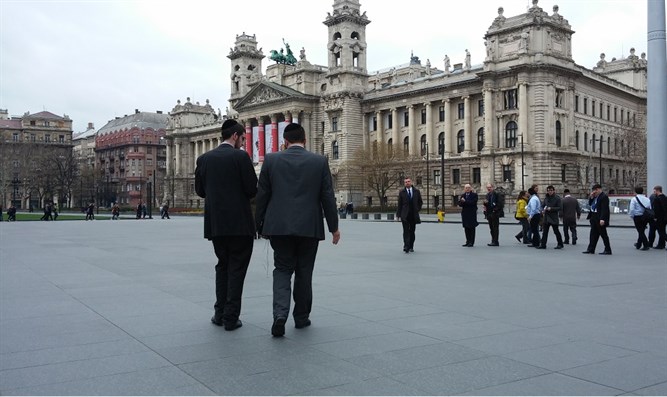
New report shows that proportion of the world’s Jewish population living in Europe today is at its lowest level for almost a thousand years.
A new report published today by the European Jewish Demography Unit at the Institute for Jewish Policy Research (JPR) shows that the proportion of the world’s Jewish population living in Europe today is at its lowest level for almost a thousand years.
The new study, entitled “Jews in Europe at the turn of the millennium” was written by leading Jewish demographers Professor Sergio Della Pergola and Dr. Daniel Staetsky. It paints an extraordinary demographic portrait of Jews in Europe, tracing its development over the best part of a millennium, and providing up-to-date estimates of population counts and trends today.
JPR Executive Director, Dr. Jonathan Boyd, has called the report a ‘must-read’ for anyone with an interest in contemporary Jewish life, describing it as “an extraordinary achievement” by two of the world’s leading specialists in the topic.
“It provides essential demographic information and context for anyone concerned with the past, present or future of Jews across Europe,” he said, “and is likely to be an essential reference source for many years to come.”
The meticulously researched report that draws on numerous communal, national and pan-European level data sources never previously examined has taken the team over a year to complete, and covers a combination of Jewish history, demography and political science.
It explores how the European Jewish population has ebbed and flowed over time. It traces its development from the twelfth century, travelling through many years of population stability until the tremendous growth of the nineteenth and early twentieth centuries, followed by the dramatic decline prompted by a combination of mass migration and the horrors of the Shoah.
Using multiple definitions of Jewishness and numerous data sources to determine the size of the contemporary population, the study proceeds to measure it in multiple ways.
It looks at the major blocs of the European Union and the European countries of the Former Soviet Union, as well as providing country-by-country analyses, ranging from major centers such as France, the UK, Germany and Hungary, to tiny territories such as Gibraltar, Monaco and even the Holy See.
The report also contains the most up-to-date analysis we have on the key mechanisms of demographic change in Europe, touching variously on patterns of migration in and out of Europe, fertility, intermarriage, conversion and age compositions.
Among its more striking findings are:
• After centuries of turmoil, growth and decline, the proportion of world Jewry living in Europe today is more or less the same as the proportion was 900 years ago. 12% of all Jews lived in Europe in 1170; today the equivalent proportion is 9%. Just a century and a half ago, it was 88%.
• In the last fifty years, Europe has lost almost 60% of its Jewish population.
• Jews feel more attached to the European Union than the general populations of EU Member States, particularly in Hungary, Poland, Austria and Italy.
• 61% of Jews in the UK think of Judaism primarily as a religion, compared to 11% of Jews in Poland who are much more likely to think of it as an ethnicity, and 9% of Jews in Hungary, who are much more likely to think of it as a culture.
• Of the countries investigated, community affiliation rates in Europe are highest in France and Italy, and lowest in the Netherlands and Hungary.
• There are 1.3 million self-identifying Jews living in Europe today, but an estimated 2.8 million have at least one Jewish grandparent or are married to someone with at least one Jewish grandparent, thereby making them eligible for Israeli citizenship under the Israeli Law of Return.
• The largest Jewish population in Europe is in France, although it is estimated to have declined by about 15% since 1975.
• There were 409,000 Jews living in Russia in 1994; today the Jewish population in Russia is estimated at 155,000, a decline of over 60% in a generation.
• About 60% of Jews in Spain today were born elsewhere – particularly in Morocco and parts of South America; over half of all German Jews were also born outside of their country of residence, mainly in the former Soviet Union. By contrast, just 2% of Hungarian Jews today were born outside of Hungary.
• Norway and Finland have the largest proportions of Israeli-born Jews in their Jewish populations – over half of the Jews living in both countries were born in Israel. By contrast, there are vanishingly few Israeli-born Jews in the Jewish populations of France, Hungary and the Baltic States.
• 335,000 European Jews emigrated to Israel in the first two decades of the twenty-first century, with the largest numbers coming from Russia, Ukraine and France, who, together, comprise 84% of the whole.
• Of the countries investigated, intermarriage rates are lowest in Belgium, where just 14% of Jews are estimated to be married to non-Jews. They are highest in Poland, where the equivalent proportion is 76%.
Beyond the value of the report itself, Jonathan Boyd was quick to note that the real value of the study is in the data that underlie it.
“Our primary purpose in doing this work is to ensure that we are well-placed to help Jewish organizations operating throughout Europe to understand population dynamics in their community.”
“The data outlined in this report can be used in multiple ways to help European Jewish bodies to plan effectively for their future, and we are determined to do all we can to enable community leaders to draw on the data to help foster Jewish life.”
(Arutz 7).